Affiliate Links Explained: What They Are and How To Create Them
The affiliate marketing industry is projected to reach $15.7 billion by 2024, so if you’re not already, it’s high time to get in on the action as part of your marketing efforts.
The ingredients to set up your own affiliate program are pretty simple. All you’ll need to start are affiliate marketers and a way to track their performance. Enter affiliate links! These unique URLs make it easy for everyone involved: you as the business or affiliate manager, the affiliate marketer as well as the potential leads or referrals they bring in.
In this post, we get into the details of exactly what affiliate links are, how they work, and how you can create them to track your affiliate campaigns. Discover the art and science of creating affiliate links for performance tracking and intelligent commission allocation.
We also offer some advice, tips and tricks, as well as examples of the best affiliate programs. Most importantly, we show you how you can use affiliate marketing tools like Referral Factory to easily (and affordably!) generate links and manage tracking.
Ready to get started with an affiliate marketing program?
Table of Contents
What Is An Affiliate Link?
An affiliate link is a unique url that contains a unique affiliate ID or affiliate code. This link is shared by the affiliate to promote products or services in exchange for a commission on each click, lead, sale or conversion made through their referral. An affiliate marketer plays a crucial role in promoting products and services, earning commissions by driving sales through these unique affiliate links.
Typically, an affiliate link will redirect the person who clicks on it (your potential lead or customer) to a destination url such as your business’s own website or a lead generation form where they can claim a special offer or gain access to exclusive discounts.
Affiliate partners can share these unique links in social media posts (a la influencer marketing campaigns), with their site visitors, in YouTube videos, via email marketing or their own promotional materials. Where they share their link will depend on the type of affiliate (partner, content creator, social media influencer, etc.).
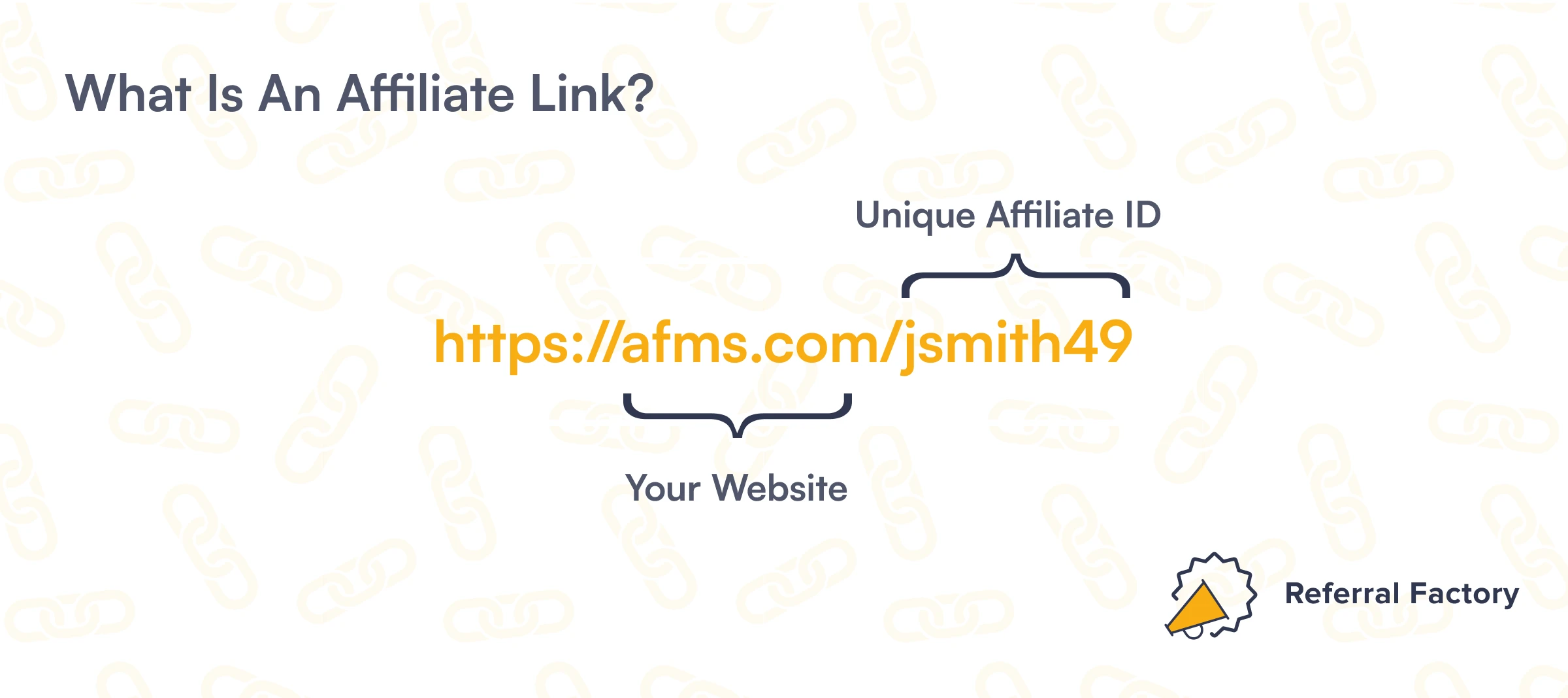
Enter your website below to build an affiliate program for your business in seconds:
Why Are Affiliate Links Important?
Tracked affiliate links are crucial to launching a successful affiliate program for several reasons.
First, affiliate links allow for accurate tracking so that clicks, leads and sales can be correctly attributed to the affiliate partner. Each affiliate is assigned their own unique affiliate link, which enables the affiliate system to track and credit them for the purchases made by their referrals.
This ensures that affiliates are properly compensated for their efforts with a commission or finder’s fee, motivating them to continue promoting your business’ products or services.
Second, affiliate links provide a seamless user experience. When a potential customer clicks on an affiliate link, they are directed to your website or a special landing page. This helps to build trust and credibility for both the affiliate and the business.
Additionally, affiliate links enable the measurement of the affiliate program’s performance. By analyzing the data from affiliate links, businesses can determine which affiliate partners are driving the most leads or conversions, which marketing strategies are most effective, and what optimizations can be made to improve overall performance. This data-driven approach allows businesses to optimize their affiliate program for better results over time.
Affiliate Links vs Affiliate Codes: What’s Better?
Affiliate links and affiliate codes are both powerful tools in the world of affiliate marketing. Both attribute a unique affiliate id to aid in tracking. However, they vary in their use, benefits, and tracking capabilities.
An affiliate code is a unique identifier assigned to an affiliate marketer to track sales or leads generated through their promotional efforts. When the code is used (inside an affiliate link or via some other distribution method), it allows the business to attribute traffic and sales to the specific affiliate, who then earns a commission based on the tracked performance.
Here is an overview of the pros and cons of using affiliate links vs affiliate codes:
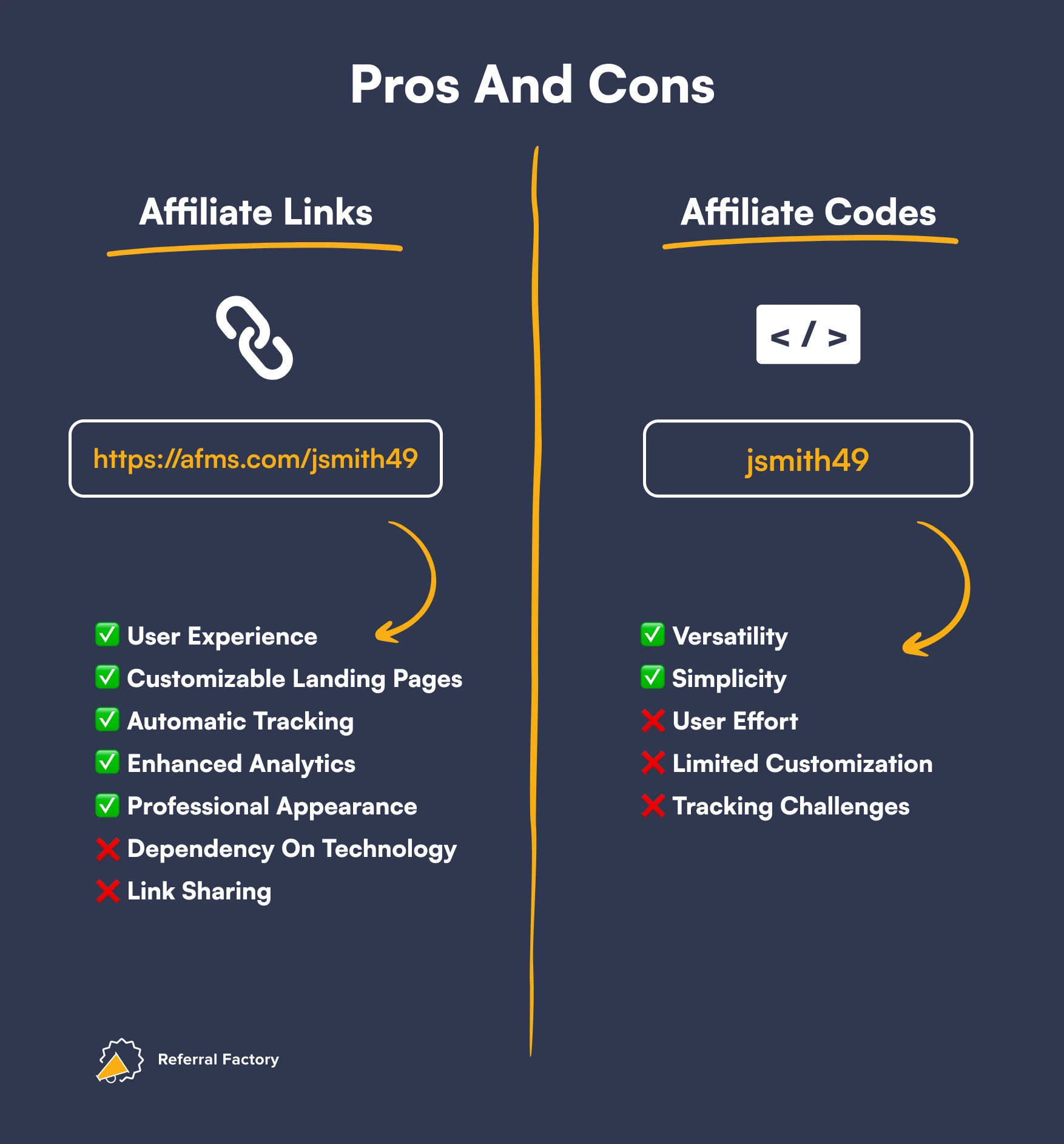
Affiliate Links
Pros:
✅ User Experience: Affiliate links offer a seamless user experience. Potential new customers can click on the link and be directed straight to the product or service without the need for additional steps or explanation. For the end user, there is no need to copy or remember a code and for you as the business, there is no need to set up a special input field for these codes in your website.
✅ Customizable Landing Pages: Affiliate links allow businesses to create customized landing pages that tailor content, design, and user pathways to increase the likelihood of conversion. You can also use these landing pages to offer something special, like a discount or priority service, which makes it more likely that you will get the lead’s details, even if they don’t immediately convert.
✅ Automatic Tracking: Clicks and conversions can be automatically tracked, enabling real-time performance analysis and optimization.
✅ Enhanced Analytics: Since they are used at the beginning of the conversion journey and not only at checkout, you can gain richer analytical insights, like user behavior, click-through rates, and the overall customer journey using affiliate links.
✅ Professional Appearance: Affiliate links look professional, contributing to a better brand image.
Cons:
❌ Link Sharing: Since links are digital, they might not be as convenient for verbal promotions compared to affiliate codes. This is why affiliate codes are so popular in podcasts!
❌ Dependency on Technology: If there are technical issues such as a broken link or site downtime, it could disrupt the user experience and potential sales.
Affiliate Codes
Pros:
✅ Versatility: Affiliate codes can be used both online and offline, making them versatile for various promotional settings, including verbal or print. They are best suited to e-commerce businesses with an online store where you already have a place to input promo codes.
✅ Simplicity: Codes can be easy to remember and share, which could be beneficial in a conversational or social media context.
Cons:
❌ User Effort: Potential customers have to remember and manually enter the code during the checkout process, which might lead to a loss in conversions if they forget or abandon their journey. In other words, links with custom landing pages often mean you can get the details of your lead pre-conversion, so you can subscribe them to your newsletter or nurture them over time.
❌ Limited Customization: Unlike affiliate links, codes don’t allow for tailored landing pages, missing the opportunity to optimize the user experience and messaging. It also means that you’ll need to add an input field in your website at checkout or at your point-of-sale that can recognize those codes.
❌ Tracking Challenges: While still trackable, codes might not offer as robust analytical insights as links, making performance optimization slightly more challenging. This is because
Both affiliate links and affiliate codes have their own strengths and weaknesses in the realm of affiliate marketing. Affiliate links offer a more seamless user experience, customizable landing pages that can include special offers, automatic tracking, enhanced analytics, and a professional appearance.
On the other hand, affiliate codes are versatile for various promotional settings, especially if they are easy to remember and share. Think podcasts and live events. However, they require users to manually enter the code during checkout, which you’ll have to make possible on your website or at your point-of-sale, they often lack some customization options, and may pose tracking challenges.
Affiliate codes are best suited to businesses with already established brands and online checkouts.
Ultimately, the choice between affiliate links and codes depends on your business’ specific marketing objectives, target audience, and promotional channels. It’s important to weigh the pros and cons of each option to determine which is the best fit for maximizing leads, conversions and success in your affiliate program.
How To Create An Affiliate Link
To create affiliate links, you will need to decide whether to custom-build the tracking capabilities with the help of a developer or whether to use a no-code affiliate marketing tool like Referral Factory to generate the affiliate links for you. Using off-the-shelf affiliate management software is usually the most popular solution as it allows you to get up and running in days — rather than months.
Using Affiliate Software vs Hiring A Developer
Affiliate software comes with all the tools and functionalities that are specifically designed for managing referral and affiliate programs, such as tracking leads from affiliates, calculating affiliate commissions, and analyzing performance data.
Many of these tools (including Referral Factory) go as far as managing the payouts and rewards for your affiliates, taking care of what can end up being a strain on your finance department.
Opting for pre-built affiliate software can also be cost-effective, as it eliminates the lengthy development time and resources required to build a system from scratch. Since these affiliate systems are built expressly to track affiliate links, they’ve already taken into account the features you may need.
Using affiliate software has the added advantage of connecting you to established affiliate networks. This means that even if you don’t already have a team of affiliate marketers, you can easily find and collaborate with them through the software.
Affiliate software also typically comes with customer support, providing businesses with guidance and troubleshooting when necessary.
However, one potential downside is that off-the-shelf software may not fully align with your business’s unique needs and workflows. It might also be less adaptable to evolving business strategies and market trends, and there could be limitations in terms of customization and scalability.
On the other hand, building a customized tracking system offers the benefit of tailor-making the system according to the specific needs and objectives of your business. A customized solution allows for greater flexibility and adaptability, meaning that the system can evolve alongside your business and market changes. However, the custom-build route comes with its own set of challenges, primarily in terms of the investment required.
Developing a customized system demands substantial time, technical expertise, and financial resources. Additionally, you would then take on the responsibility of maintaining the system, troubleshooting issues, and ensuring continuous improvements and updates, which can be resource-intensive.
To decide, you should weigh the immediate convenience and reliability of off-the-shelf software against the flexibility, adaptability, and long-term strategic alignment offered by a customized solution. The choice should be informed by your business’s specific needs, technical capabilities, resource availability, and long-term vision for your affiliate marketing program.
How To Brief a Developer to Create Affiliate Links
Crafting a concise, comprehensive brief to your developer is crucial for effectively creating affiliate links. Make sure that you clarify your affiliate marketing goals, desired features, tracking necessities, and the look and feel for your affiliate links.
- Set clear and achievable objectives for your affiliate program.
- Mention any required technical functionalities in detail, such as url parameters and redirect rules.
- Highlight the importance of search engines (SEO) in the context of creating affiliate links.
- Specify your preferred affiliate link structure, such as whether you want unique ID’s or alphanumeric codes.
- Emphasize the importance of proper tracking. Details should include click rate, conversion rate, and source tracking.
- Ensure that the developer understands the need for responsiveness in various browsers and devices.
- Give the developer the full spec of your existing tech stack to see what software can be integrated to optimize performance and tracking.
- Include a deadline for the project while offering a reasonable time for revisions.
How To Choose Affiliate Software
When choosing affiliate software, start by evaluating your specific needs and goals. Consider the scale of your affiliate marketing program, the type of products or services you offer, and the kind of affiliates you want to work with. If you’re just starting out, look for software that is easy to set up and user-friendly. For more established businesses, advanced features like custom commission structures, detailed analytics, and integration with other marketing tools might be crucial.
Next, consider the software’s tracking and reporting capabilities. Accurate tracking of clicks, sales, and commissions is essential for managing your affiliate program effectively. Look for software that offers real-time reporting, so you can monitor performance and make informed decisions quickly. Additionally, ensure that the software provides transparent and detailed reports that your affiliates can access, fostering trust and collaboration within your network.
Finally, take into account the level of support and resources available from the software provider. Reliable customer support can make a significant difference, especially if you encounter technical issues or need assistance optimizing your program. Look for providers that offer comprehensive support, including tutorials, FAQs, and responsive customer service. Reading reviews and seeking recommendations from other marketers can also help you choose software that has a proven track record of success.
How To Build An Affiliate Program With Referral Factory
With Referral Factory, you can build, launch and manage affiliate programs without needing a developer. (You can also use Referral Factory to run customer referral programs or track your social media influencers, by the way!). Here is a step-by-step breakdown of how to create links for your affiliates using Referral Factory:
Step 1: Build Your Affiliate Campaign
Build your affiliate campaign from scratch, using AI, or use a pre-built affiliate program template like this one.
Step 2: Optimize Your Lead Conversion Path
Spend some time optimizing the landing page that will open when someone clicks on one of your affiliate’s links. With Referral Factory, you can customize a lead generation form to be 100% on-brand for your business, with your own logo, fonts, colors, and copy. You can also add images and videos to make the page more dynamic and engaging.
This page should have a clear call to action and can be automatically personalized to each of your affiliates. We recommend adding some kind of special offer or exclusive deal as a way to drive conversion.
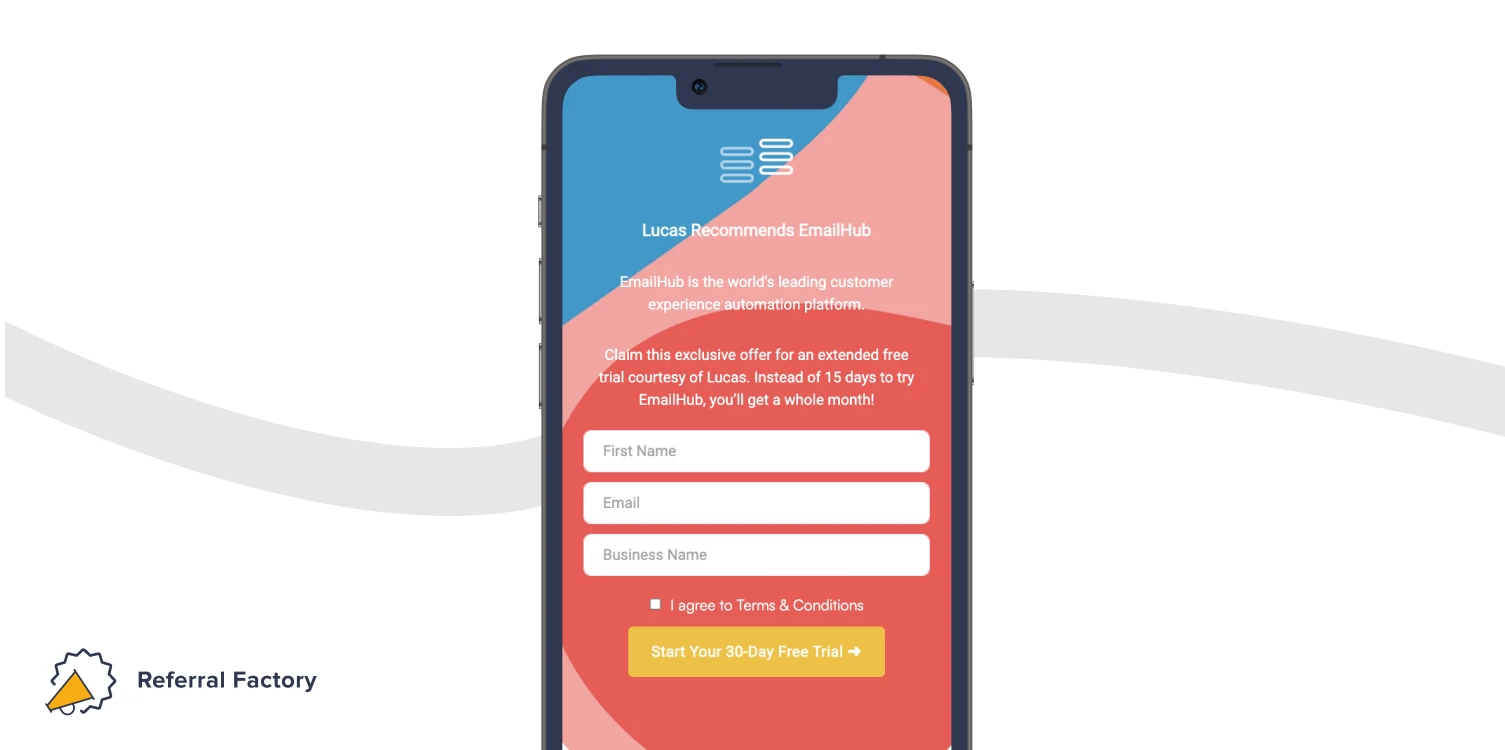
Step 3: Decide How To Enrol Affiliate Marketers
Consider how your affiliate partners will get their unique link. If you don’t know who your affiliate partners will be just yet or if you want them to explicitly opt in, you can build a page where they can sign up to join your affiliate program.
By forcing affiliates to agree to some terms and conditions, you cover your legal bases and make sure that everyone is on the same page.
However, you also have the option to enrol your affiliates on their behalf and automatically generate their affiliate links. You can do this by uploading a spreadsheet with your affiliate’s names and email addresses, or even sync their details via your CRM.
Once you have the list of affiliate links, you can distribute them via Referral Factory or your own email marketing channel.
It’s important to know that how to find affiliates to promote your business can be one of the trickiest parts of running a successful affiliate marketing program so think carefully about your strategy!
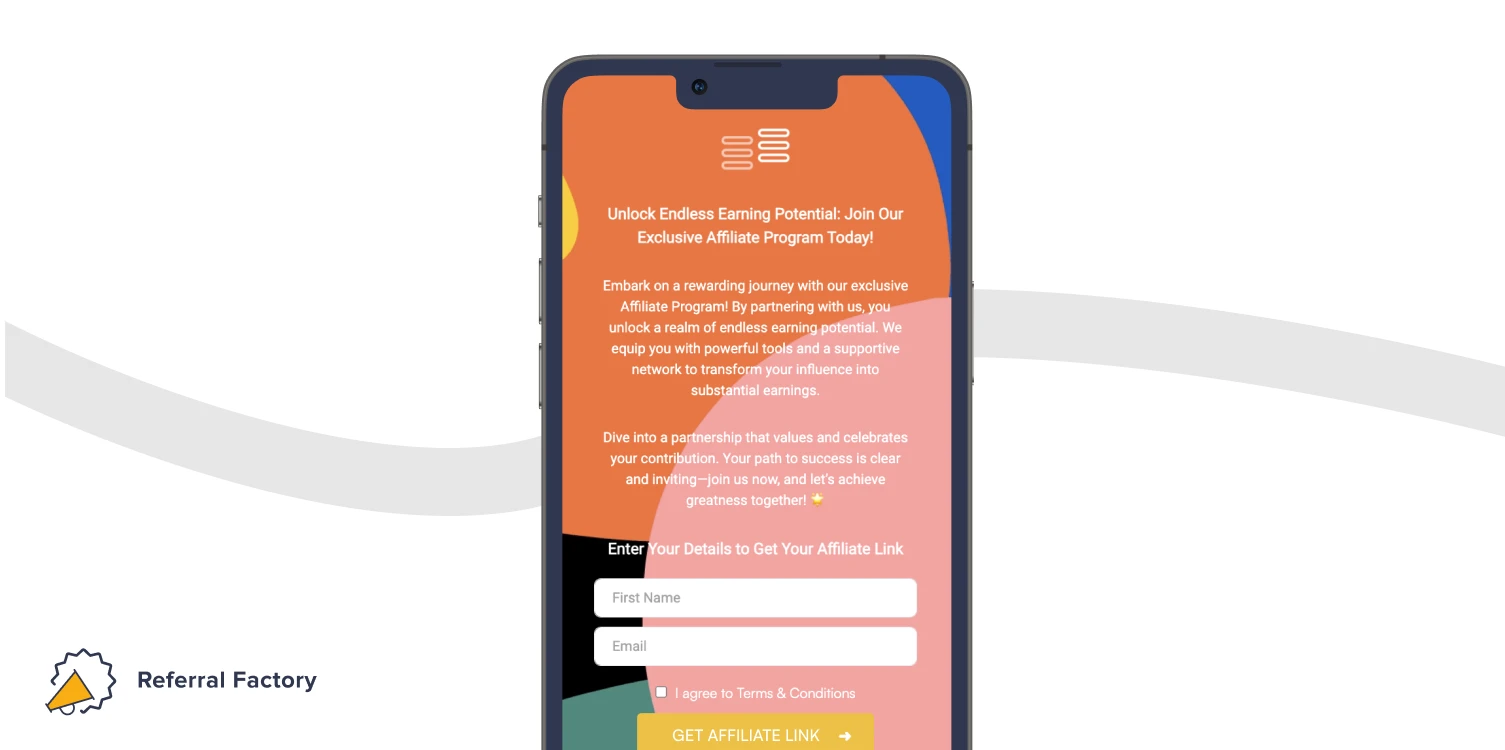
Step 4: Build An Affiliate Dashboard
Build an affiliate dashboard so that your affiliates can have easy access to their affiliate link and performance metrics. You can also use this page to offer free resources and advice on how best to promote your company’s products or services.
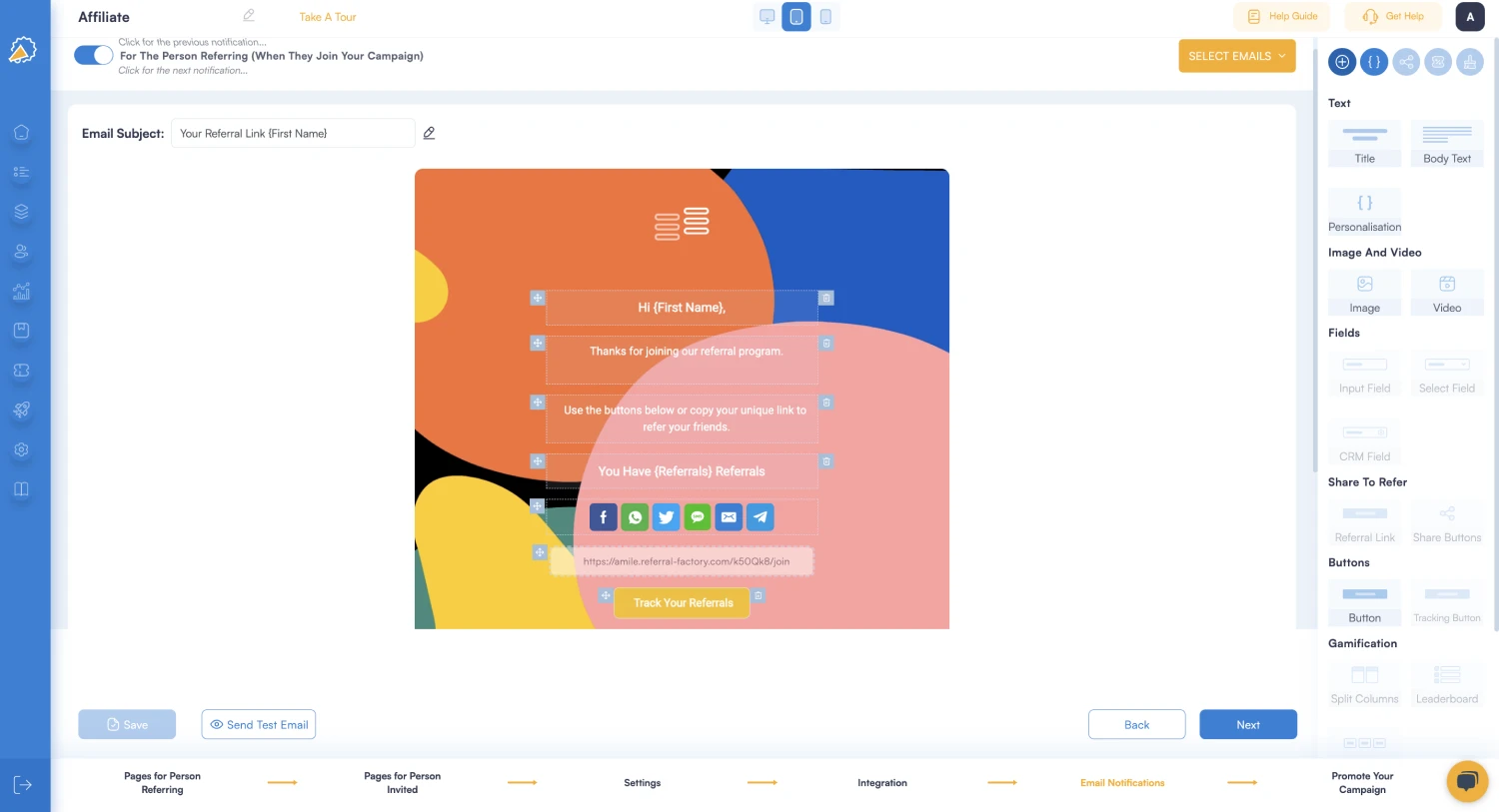
Step 5: Calculate Commissions and Set Up Automated Payouts
Referral Factory makes it easy to manage the financial aspect of your affiliate marketing campaigns. Simply set up a reward to automatically calculate and even pay out your affiliate commissions. You can pay affiliates on lead acquisition or conversion or both.
Tracking Affiliate Marketers’ Performance
To ensure the success of your affiliate program, it’s really important to understand the key metrics that matter when it comes to understanding your return on investment. These may include click-through rates, conversion rates, and overall sales or conversions by affiliates.
You should also familiarize yourself with what affiliate marketers call “conversion path analysis”: the journey or steps a lead takes from their initial interaction with an affiliate link to completing a desired action, such as making a purchase or signing up for a service. This analysis is crucial for optimizing marketing strategies and improving conversion rates.
Understanding the Importance of Tracking Performance
Performance tracking is the backbone of a successful affiliate marketing program. It unlocks valuable insights, and helps your grow your affiliate program into a powerful marketing channel. You should track your performance because:
- It will show the effectiveness of your affiliate marketing strategy
- It will help you notice high-performing affiliates that you can offer special incentives to
- It will identify the platforms where the affiliate links are driving the most traffic
- It will help you recognize the affiliate marketing tactics that are not working, allowing you to make timely changes
- It allows you to measures the ROI (return on investment) of your affiliate program
- Optimizing your marketing efforts can significantly impact these performance metrics
How To Analyze Your Performance Metrics in Referral Factory
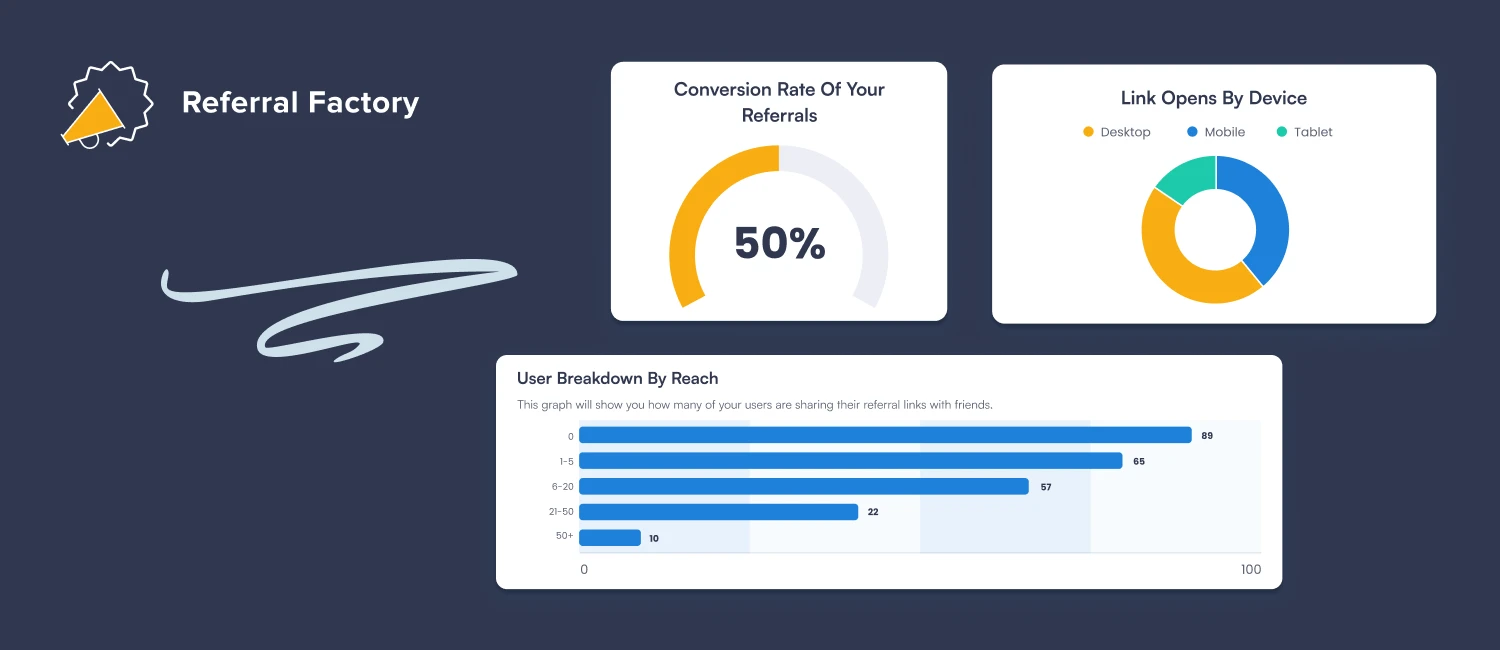
With Referral Factory, you can pinpoint the following data:
1. Reach/ Clicks: How many people are clicking on your affiliates’ links. These are the potential leads who are showing interest in your offering but may not necessarily take the next step.
2. Leads: How many people are registering their interest via an affiliate link. These are the leads you should be nurturing to move them towards conversion.
3. Conversions / Sales: How many people are qualifying or converting via an affiliate link (this means they make a purchase or take some kind of action.)
It’s important to track all these metrics so that you can see which of your affiliates are promoting their links the most (reach/ clicks) and which or your affiliates are generating the most interest (leads). But, most importantly, you want to know who your money-making affiliates are (conversions/ sales). So, being able to track whose affiliate link generated the most sales is key!
Allocating Affiliate Rewards or Commissions

When it comes to affiliate marketing, payment structures are usually designed to be performance-oriented, ensuring that affiliates are compensated fairly and accurately for the traffic, leads, or sales they generate. Affiliate links pay through various models such as Cost Per Sale (CPS), Cost Per Lead (CPL), and Cost Per Click (CPC), with commission percentages ranging from 1% to 20%.
Payment to affiliates is mainly based on the completion of specific actions, commonly referred to as conversions, which are determined and agreed upon by both parties beforehand. There are three main actions on which you can pay your affiliates: Cost Per Sale, Cost Per Lead and Cost Per Click:
Cost Per Sale (CPS): Affiliates earn a commission or flat rate when the referred customer makes a purchase or pays for a service. This is the most common compensation model.
Cost Per Lead (CPL): Affiliates earn a commission or a flat rate when a referred user becomes a lead — when you get their contact details — such as signing up for a trial or subscribing to a newsletter.
Cost Per Click (CPC): Affiliates are paid based on the number of clicks generated through their affiliate link, regardless of whether or not the customer makes a purchase.
Whatever you do, don’t agree to an affiliate deal on this payment structure! Cost per click affiliate deals are riddled with fraud. Paying per click means there is no incentive for the affiliate to bring you REAL customers, just clicks. This method is only advised if you are working with content creators to increase your rankings via search engine optimization.
How Much Commission Should You Pay Your Affiliates?
Even though we’ve just said this, it bears repeating: you should ideally being paying per sale, and in some rare cases per lead. Paying per click is an invitation for fraud!
But how much do you actually have to pay per sale?
We have a slightly different view on this to most of the advice out there: we recommend paying out a fixed rate per conversion. This helps affiliates know EXACTLY how much they will get per sale and helps you budget accordingly.
In many cases, however, affiliate programs run on commissions — and the industry standard is to pay 15% to 30% of the customer’s total spend. The newer your brand and less known it is, the higher commission you should typically pay. This will attract affiliates to try promote something new.
Some affiliate programs pay commissions once-off and some pay them on a recurring basis, and the latter is especially popular with subscription based models like in SaaS (software-as-a-service). We advise paying a once-off commission because, well, it’s simply easier to manage! However, in some cases companies pay a quarterly commision based on total spend.
Whatever you choose, the best approach is to keep it as SIMPLE as possible. This isn’t just important to help you manage your affiliate marketing efforts, it’s also better for the affiliate marketer as it’s more transparent.
How To Pay or Reward Your Affiliates
Having an automated payment system can make or break your affiliate program. It simplifies everything and reduces the manual work behind managing your referral program. You want to focus on MAKING money not PAYING money 😆
We suggest finding a plug-and-play affiliate solution that handles the payments for you. This means less admin for you and a smoother payout process for the affiliate too. Most affiliate software out there will offer payouts via platforms like PayPal, Wise, and more — they will also take care of getting the relevant invoices from the affiliate, and worry about the tax implications of making payments to affiliates. So all in all it’s safer to outsource this part!
To summarize, these are the reasons you should use a platform to make your affiliate links, track the performance of your affiliate campaigns, AND handle the payments to each of your affiliates…
- Speeds up the process: No delays in handling payouts, resulting in satisfied and motivated affiliates.
- Help you avoid tax implications: Affiliates who earn more than $500 from your company may need to be registered as official contractors if you pay them directly (depending on your industry and country).
- Avoids human errors: Reduces the risk of errors in calculation and actual distribution, thereby ensuring precision in handling financial transactions.
- Saves time: Frees up resources that could be utilized in optimizing your marketing strategy and affiliate partnerships.
- Smooth and transparent system: Makes tracking and visibility easier for affiliates, helping build trust in your affiliate program.
With Referral Factory, you can set up flexible rewards to automatically reward your affiliates based on rules that you set.
Best Practices for Successful Affiliate Marketing
In this section, we will explore some key best practices for successful affiliate marketing, providing valuable insights and actionable tips to help you navigate the intricacies of running a successful affiliate program. Whether you are new to affiliate marketing or looking to enhance your current efforts, these best practices will set you on the path to success in the world of affiliate marketing.
Affiliate sites play a crucial role in promoting products and reaching new audiences, helping to generate traffic and maximize return. However, there are many pitfalls in the world of affiliate marketing because many see it as an easy space to make a passive income.
Choosing the Right Affiliates or Partners
In most cases, quality is better than quantity: your time and resources are saved by managing fewer, more productive affiliates. Choose affiliates who showcase genuine engagement with your brand and have a strong online presence.
Identifying high-engagement affiliates for your program is a strategic task. Look for those who have a high amount of traffic or followers, but also take note of their audience engagement. It’s crucial that your product aligns with their content and audience.
Selecting the right affiliates is an ongoing process requiring consistent evaluation. As your business grows and shifts, revisit your selection criteria to ensure your affiliates can effectively promote your products for maximum return.
Building and Nurturing Relationships with Affiliates
The key to running a thriving affiliate program lies in nurturing your affiliate partnerships. Successful affiliate links come not only from creating them, but also from maintaining strong relationships with affiliates. A one-time partnership rarely leads to monumental growth, so think long-term and always provide value, both for your affiliates and their audiences.
A successful affiliate program functions on a value-for-value relationship. Prioritize open dialogue about their needs, feedback about your products, or services, and continually revise your strategy based on this input. This way, you ensure mutual growth, success, and loyalty.
Sustaining affiliate relationships involves consistent and transparent communication and fair, on-time payouts. We recommend regular updates or an affiliate dashboard of some sort, where they can track their performance.
Staying Ethical and Compliant in Affiliate Marketing
It is essential to adhere to ethical and legal boundaries when running an affiliate program. Ensure your affiliates are aware of these limitations. Promote honesty, transparency, integrity, and respect for your brand and its values.
Familiarize yourself with the legal aspects of affiliate marketing. If you’re in the USA, these include complying with the Federal Trade Commission (FTC) guidelines, data privacy laws, and advertising standards.
Any breach of these rules can harm your brand image and relationship with consumers. Therefore, keep monitoring and maintain regular, open communication with your affiliates to prevent any compliance issues.
Examples of Successful Affiliate Programs
Drawing inspiration from successful affiliate programs should be an integral part of an effective affiliate marketing strategy. Case studies of top-performing affiliate programs can offer invaluable insights, guidelines, and work as instructive models.
Learning from the winners means understanding what successful affiliate programs do right. These can range from skilled selection of affiliates, compelling content creation, smart incentivization strategies, to comprehensive performance tracking.
Amazon Affiliate Program: This program effectively leverages the impressive range of products on Amazon. It offers up to 10% in advertising fees with easy linking tools and detailed reporting.
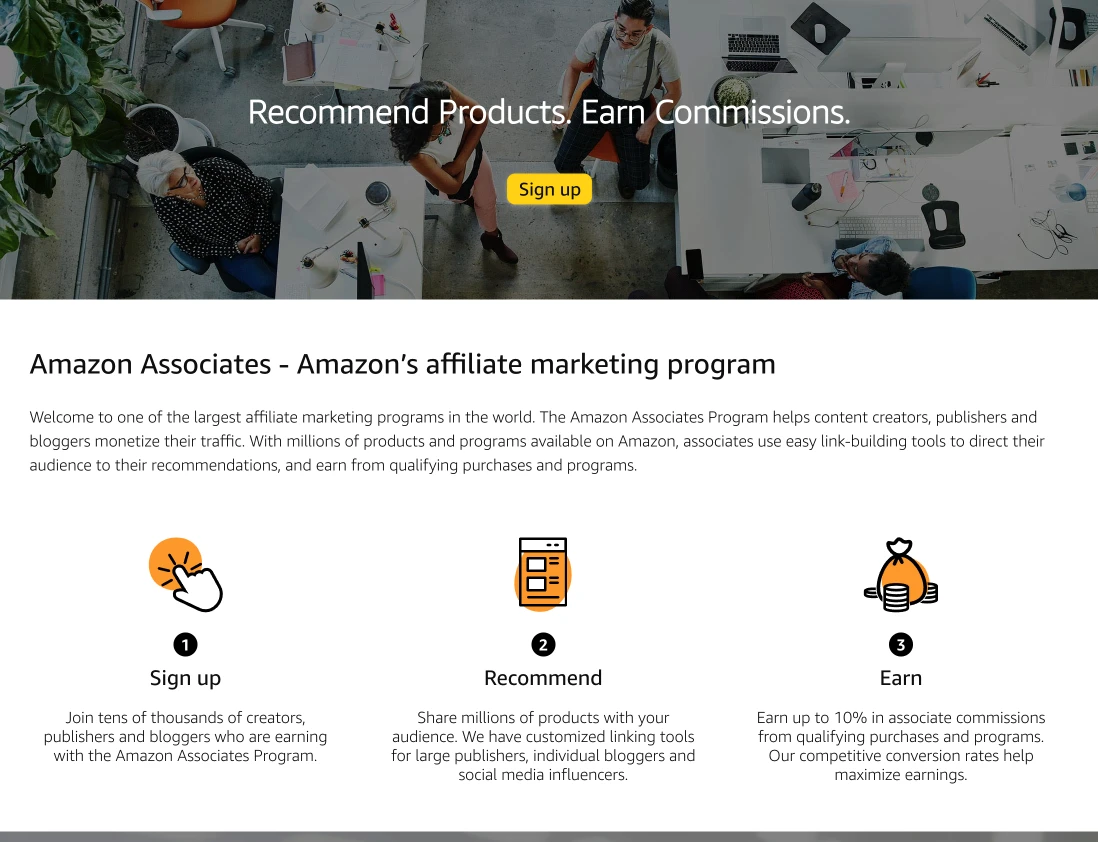
Booking.com’s Affiliate Partner Program: Booking.com provides helpful promotions, banners, and a search box feature. It also presents partners with an opportunity to earn a minimum of 25% of the commission received by Booking.com per booking.

Sephora’s Affiliate Program: This beauty retail giant offers data feeds, text links, and banners, along with an attractive commission rate. They also provide affiliates with exclusive previews and newsletters.

Bluehost’s Affiliate Program: Bluehost utilizes a tiered commission structure that delivers rewards based on performance. It also provides creative banners and promotional content for affiliates to use.

Conclusion
Creating affiliate links and tracking their performance is an essential part of an effective affiliate marketing strategy. By understanding the intricacies of generating and managing affiliate links, businesses can optimize their affiliate programs for success. Whether using off-the-shelf software or a custom-built solution, ensuring accurate tracking, performance analysis, and seamless user experiences are crucial. For those new to affiliate marketing, following best practices and leveraging tools like Referral Factory can simplify the process and drive better results. Start building your affiliate links today to unlock new revenue opportunities.




